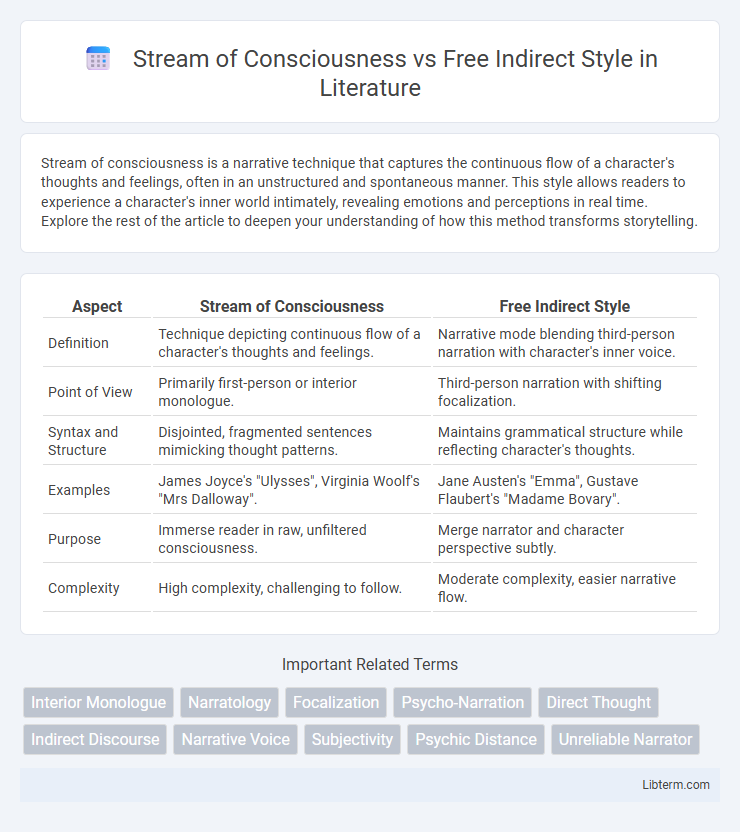Stream of consciousness is a narrative technique that captures the continuous flow of a character's thoughts and feelings, often in an unstructured and spontaneous manner. This style allows readers to experience a character's inner world intimately, revealing emotions and perceptions in real time. Explore the rest of the article to deepen your understanding of how this method transforms storytelling.
Table of Comparison
| Aspect | Stream of Consciousness | Free Indirect Style |
|---|---|---|
| Definition | Technique depicting continuous flow of a character's thoughts and feelings. | Narrative mode blending third-person narration with character's inner voice. |
| Point of View | Primarily first-person or interior monologue. | Third-person narration with shifting focalization. |
| Syntax and Structure | Disjointed, fragmented sentences mimicking thought patterns. | Maintains grammatical structure while reflecting character's thoughts. |
| Examples | James Joyce's "Ulysses", Virginia Woolf's "Mrs Dalloway". | Jane Austen's "Emma", Gustave Flaubert's "Madame Bovary". |
| Purpose | Immerse reader in raw, unfiltered consciousness. | Merge narrator and character perspective subtly. |
| Complexity | High complexity, challenging to follow. | Moderate complexity, easier narrative flow. |
Understanding Stream of Consciousness
Stream of Consciousness is a narrative technique that captures the continuous flow of a character's thoughts, feelings, and sensory experiences, often presented in a fragmented, non-linear manner. This method emphasizes inner monologue without structured punctuation or logical sequence, closely mimicking natural thought processes. Understanding Stream of Consciousness requires recognizing how it prioritizes raw, unfiltered mental activity, distinguishing it from Free Indirect Style, which subtly blends a narrator's voice with a character's inner thoughts.
Defining Free Indirect Style
Free indirect style merges the narrator's voice with a character's inner thoughts, creating a seamless blend of third-person narration and first-person perspective without quotation marks or explicit attribution. This narrative technique allows readers to experience characters' emotions and thoughts intimately while maintaining the narrative distance of third-person. Unlike stream of consciousness, which presents a raw and unfiltered flow of a character's inner experiences, free indirect style subtly infuses narrative with personal subjectivity, balancing immediacy and narrative control.
Historical Origins of Both Techniques
Stream of consciousness originated in the early 20th century, notably through the works of writers like James Joyce and Virginia Woolf, emphasizing the direct, unfiltered flow of a character's thoughts and sensory experiences. Free indirect style emerged in the 18th and 19th centuries, rooted in the narrative innovations of authors such as Gustave Flaubert and Henry James, blending third-person narration with the subjective voice of the character. Both techniques revolutionized literary expression by deepening psychological insight and challenging traditional narrative boundaries.
Key Features: Stream of Consciousness
Stream of Consciousness is characterized by an unfiltered, continuous flow of a character's thoughts and feelings, often lacking conventional punctuation and syntax to mimic natural mental processes. This technique delves deeply into subjective experiences, capturing sensory impressions, memories, and internal monologues in real-time. Prominent authors such as James Joyce and Virginia Woolf utilize Stream of Consciousness to explore complex psychological states and fragmented consciousness.
Key Features: Free Indirect Style
Free Indirect Style blends the narrator's voice with a character's thoughts, presenting internal dialogue without quotation marks or explicit attribution. This technique allows seamless shifts between third-person narration and a character's subjective perspective, capturing their emotions and opinions subtly. It preserves narrative distance while providing insight into personal experiences, making it a nuanced tool for character development and psychological depth.
Major Writers Using Stream of Consciousness
Stream of consciousness is a narrative technique that captures a character's continuous flow of thoughts and feelings, famously utilized by writers like James Joyce, Virginia Woolf, and William Faulkner. Free indirect style blends third-person narration with a character's inner voice, as seen in the works of Jane Austen and Gustave Flaubert. Major authors known for stream of consciousness prioritize deep psychological insight and fragmented, nonlinear expression to immerse readers in the mind's spontaneous patterns.
Major Writers Using Free Indirect Style
Major writers employing free indirect style include Jane Austen, whose novels like "Emma" masterfully blend narrator and character voices, enabling nuanced psychological insight. Gustave Flaubert's "Madame Bovary" exemplifies free indirect speech by seamlessly merging character thoughts with third-person narration, enhancing narrative depth and irony. Modern authors such as Virginia Woolf and James Joyce incorporate free indirect discourse to varying extents, though Joyce's works often pivot more towards stream of consciousness techniques.
Narrative Perspective and Voice
Stream of consciousness employs a first-person narrative perspective that immerses readers directly into the protagonist's unfiltered thoughts, emotions, and sensory experiences, creating an intimate and immediate voice. Free indirect style blends third-person narration with the character's inner voice, allowing the narrator to subtly adopt the character's tone and viewpoint without explicit markers like "he thought" or "she felt." This technique offers a flexible narrative voice that smoothly oscillates between external description and internal consciousness, enriching character development and reader engagement.
Effects on Reader Experience
Stream of Consciousness immerses the reader directly in a character's uninterrupted thoughts and perceptions, creating an intense, intimate connection with their inner world but sometimes challenging narrative clarity. Free Indirect Style blends a character's voice subtly with the narrator's perspective, enhancing psychological depth while maintaining narrative coherence and fluidity. The former evokes immediacy and raw emotion, whereas the latter offers a nuanced, layered understanding of characters within a structured narrative framework.
Choosing Between the Two Styles
Choosing between stream of consciousness and free indirect style depends on the desired narrative intimacy and clarity; stream of consciousness offers raw, unfiltered access to a character's thoughts, ideal for deep psychological exploration, while free indirect style blends the narrator's voice with the character's perspective, maintaining narrative coherence and subtle subjectivity. Stream of consciousness suits experimental or highly introspective works, demanding readers' active engagement to navigate complex, often nonlinear thought patterns. Free indirect style is preferable for balanced storytelling, providing insight into characters' minds without sacrificing readability or narrative flow.
Stream of Consciousness Infographic

 libterm.com
libterm.com